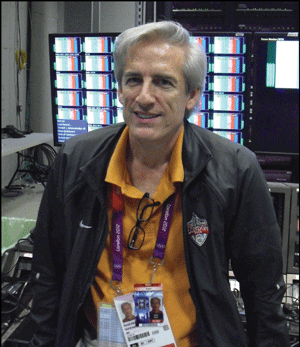A True Multiplatform Games

LONDON -- Dave Mazza, vice president of engineering, NBC Olympics is the “go to” guy when it comes to implementing the network’s latest technology to cover the biennial event. Just before the London Games ended, he sat down with Mark Hallinger, editor of TV Technology Europe and TV Technology Asia/Pacific, to discuss how the network produced the Games.
TV TECHNOLOGY: Congratulations on another successful Games. Was this less stressful in any way, compared to Athens or Beijing?
MAZZA: It’s interesting because they’re getting so much more complex. If you look back to Athens, we didn’t have any streaming... that I remember. We had a little bit of .com, I think they had eight DV tape machines we’d feed. China was so much more complex than that. A lot of the stuff we’re doing here we debuted in China, but we’ve got more, lots more of it.
TVT: How would you characterize the 2012 London Olympics? Last time we talked about software releases as an analogy, Olympics 1.0 was Atlanta, Sydney was 2.0, the massive changes in Beijing were 3.0, and Vancouver was Olympics 3.1. Here, I keep thinking “mature product,” maybe because of the enterprise media asset management hitting a long pursued goal?
MAZZA: Well, certainly, finally, finally having the hi- and low-res tied together (in the MAM), which we’ve wanted to do from the very beginning, is a big deal. We couldn’t really afford to do it before. If you go back 10 years in our asset management progress, we started in SD (and) we started with proxies because we knew we were going to need them when we got to HD.
We started with proxies in 2004, really for two reasons: One was to be able to see what was on the 3-hour IMX tape before you even pop the tape. And there was an industry standard for SD production, a file format had been somewhat standardized, and the Avid could deal with it, the tape machine could make it, and the disk recorders could record it. When the HDCAM period came (Torino 2006) there wasn’t really a file standard across manufacturers.
TVT: What are the new or expanded technologies here? How about the use of JPEG2000 at an Olympics, is that a first?
Get the TV Tech Newsletter
The professional video industry's #1 source for news, trends and product and tech information. Sign up below.
Dave Mazza MAZZA: We probably had a little bit of JPEG2000 here and there before, but here we had so many feeds going back and forth. There’s quite a bit of bandwidth between London and New York, and it’s not as expensive as other cities. (Because of this) we could afford to use the much lighter compression of JPEG2000.

A lot of people think you would go to JPEG2000 for the picture quality. It is excellent, but we chose to use it on the air where we needed low latency. We used it anywhere we had a producer and director in one country for example, and their camera operator or the announcers in the other… anywhere where somebody’s going to say “pan left,” if they have to wait three and a half seconds to see the camera move, that’s not going to be very popular.
TVT: The record wall and ingest have seem some big changes. You’re recording to a hard drive on Sony XDCAM Stations (XDS PD1000) at first, then transferring to a Harmonic MediaGrid, then sending the file to a second MediaGrid in New York via the ProCast software. Why not go directly into the MediaGrid?
MAZZA: A couple of reasons. The ingest channel—whether it’s an (Avid) Multi Stream or an XDS or an EVS—provides local disk recording right there on that same device. For example, let’s just say there was trouble with Cisco or with the switch that connected all 50 of those XDS stations to the MediaGrid, all your recording stops. That’s all your eggs in one basket.
TVT: This way you still have the recordings.
MAZZA: Yes, so on the XDS they’re all recording, and as soon as they start recording internally they start doling out an FTP session that’s set up for the hi- and low-res and that starts transferring to the MediaGrid. But if there is any issue with the MediaGrid, or the connection to the MediaGrid, or traffic on the MediaGrid, that doesn’t matter because the Sony is capturing the ingest locally. So it’s part of distributing the risk across all your different ingest channels.
TVT: And recording on XDSs has something to do with proxy creation too?
MAZZA:It also simultaneously makes proxies. We’ve been streaming the low-res out of the XDCAM decks for two games, both China and Vancouver. But with the XDS we can stream the hi-res also.
TVT: This was a third Olympics with Surround and it seems you’ve settled on an approach that works well?
MAZZA: One of the bigger things we did do was with Surround Sound. I think we finally got a method that really worked well, and that is using three- and six-channel modes. Instead of doing either stereo, which we did the past two games, or surround, we divorced ourselves from stereo, so we don’t really have any stereo mixes. We have either three-channel mixes for stereo or six channels for Surround.
TVT: What other technologies or designs have come online since Beijing? I know that getting the enterprise media asset management working well was big, but that’s not a technology.
MAZZA: That’s an effort, by vendors and by our guys, and that was pushed heavily by our side to get everybody to do that.
It didn’t make things easier, but the plethora of high-speed cameras has certainly made the viewing experience better. We didn’t deploy so many of them because the host, thankfully, was doing a whole bunch of them. I think that’s one thing that was quite evident on the coverage… high-speed cameras all over the place.
Also, virtual graphics keep getting better, you know, and I think we’re seeing them mature, we try to only use them where it’s really enhancing the experience, not just glitzing it up. If it’s adding some value to the viewer, then we’ll try to do it.
What else? It’s really not that new but both (host broadcaster) OBS and NBC are deploying MADI audio distribution, even though it’s been around for years. It just didn’t get used that much in the U.S. and this time both OBS and NBC used it. They’re giving us almost all our audio splits as a MADI stream. So that simplified cabling.
What else? I think IP, I think general IP everything.
TVT: Beyond the intercoms?
MAZZA: IP tally lights, IP video, for example, we’re moving video with some low latency Haivision IP codecs, moving video back to where an announcer is. I think IP video squarely should be on that list… we certainly embraced a lot more of this than we ever have.
I think probably the biggest technical rollout that was both an experiment and was a requirement was all the IP video, the 60 streams on the web. We took the new media package from OBS—that was 40. We added 10 of our own, from the MDS (the host multichannel distribution service). And then we added, I think, eight encoders of our air outputs from New York and they came back here, and then we added the Gold Zone and the multiviewer. That was what made up the 60 streams.
And then on top of that we had things like the Haivision IP encoders and the whole Cisco headend IPTV system that was moving content to the venues and our client hotel. So I think IP was both an experiment and a deployment.
TVT:What started here will we see more of next time?
MAZZA:It’s hard to replicate what you’re going to run into. It’s the same with the MAM. That’s a good example. We were retrieving from our robotics server in Stamford (Conn.) all the way through to London, and that allowed us to bring less of our permanent archives here. So now that we have some confidence in that, some history in that, we’ll do more of that. So that started in a small way.
We retrieved archives from home. That was new. We hope next time to be able to pull archives out of the venue servers and have it go through the IBC all the way to home. So we sort of dabbled in that here, but didn’t really try to take it on, because we’re archiving out of the three big venues on small MediaGrids.
TVT: I heard from Bob Dixon that he’s retiring soon.
MAZZA: Yes, we’re very sad about that but he leaves a long legacy. He helped NBC do the first stereo games in Seoul, 1988. And then we did our first matrix encoding, Dolby matrix surround encoding in 1996. And even though we started Surround Sound in 2006 and did a lot of Surround in China, this is the first time we really successfully pulled it off everywhere.
So, I think he’s happy that before his career ended he got to see Surround fully deployed as it was here and have it sound so much better than it has in the past. We’re gonna miss Bob. He also helped us develop a lot of the kind of crazy “Pure World” workflows that we’ve had to invent going back to Athens.
TVT: The Tielines and such.
MAZZA: Yes, and much of the other work that’s done behind the scenes was Bob. It’s not audio in the purest sense of the word, also comms-related things, how you make it so the producer can be there and the director can be over there and the talent’s over there and this guy can hear talkback and this guy can hear mix-minus. It’s all kinds of things, and Bob was involved in all of that over the years, so we will very much miss him.
TVT: Biggest surprise of these games?
MAZZA:I think the biggest positive surprise was that all of the hype and all of the multiple ways we were putting content out there, it seemed to only help the primetime audience. China was predominantly live, you know all the swimming races were live, all the gymnastics were live because of the time zone… and we thought we couldn’t beat that. And somehow on tape we were beating China most nights.
